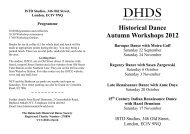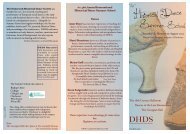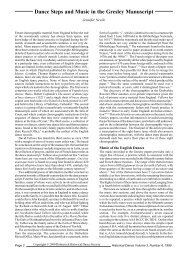Pages 9-12 Rogers - Dolmetsch Historical Dance Society
Pages 9-12 Rogers - Dolmetsch Historical Dance Society
Pages 9-12 Rogers - Dolmetsch Historical Dance Society
Create successful ePaper yourself
Turn your PDF publications into a flip-book with our unique Google optimized e-Paper software.
Sets, Victoria, The Royal Victoria, Her Majesty’s Favourite.<br />
These are followed by a description of the Polka as a<br />
couple dance, followed by its use in a Polka Cotillion (not<br />
the 18th century square dance but a combination of circle<br />
dancing and display items). A description of the steps of<br />
the Valse à Deux Temps is followed by descriptions of the<br />
form of the Circassian Circle and Spanish Dancing in waltz<br />
time. No figures are given. A description of a Gallop<br />
Quadrille and Mazurka figures is followed by a set of<br />
Mazurka Quadrilles, The Royal Devonshire Mazurka.<br />
There follows a brief mention of the Polonaise, then some<br />
Waltz Cotillion figures (the type of cotillion mentioned<br />
above) and the last dance is a Scottish reel danced as a<br />
progressive threesome rather as we now dance The Dashing<br />
White Sergeant.<br />
Cellarius<br />
La Danse des Salons<br />
1847<br />
In French.<br />
Cellarius<br />
La Danse des Salons,<br />
Jérôme Millon, Grenoble, 1993.<br />
A modern and more easily obtainable reproduction of the<br />
1849 edition, preceded by an additional article on Cellarius<br />
and his influence on dancing.<br />
Cellarius<br />
The Drawing Room <strong>Dance</strong>s<br />
English translation.<br />
E. Churton, London, 1847<br />
A translation of Le Danse des Salons.<br />
Cellarius<br />
Fashionable Dancing<br />
English translation.<br />
Vizatelly Bros. & Co., London, c.1847<br />
Another translation of Le Danse des Salons .<br />
Contents of these books are: general comments on dancing<br />
to page 16; description of First Set danced in the abbreviated<br />
manner of Paris salons at that time; description and<br />
steps of the Polka, the Waltz of Trois Temps, the Waltz of<br />
Deux Temps; advice to waltzers; steps of the Waltz of Cinq<br />
Temps; description of mazurka steps followed by a Quadrille<br />
in mazurka Time (Cellarius’s Second Mazurka Quadrille);<br />
description of a Waltz Mazurka, The Cellarius<br />
Waltz and The Redowa. The book concludes with a<br />
description of the later, or 19th century Cotillion, an<br />
alternation of couple dancing with party games or ‘forfeits’.<br />
Eighty-three figures are described. This is the dance<br />
that was known in America as The German.<br />
Willock, H.D<br />
Manual of Dancing<br />
Glasgow, c.1847, 61 pages<br />
Calls are given for eight sets of quadrilles and two single<br />
quadrilles, La Russe and the Waltz Cotillion. There are<br />
also descriptions of fourteen couple dances, four reels and<br />
twenty-nine country dances, ten of them to Scottish tunes.<br />
No music.<br />
Bland, Prof., et al<br />
The Art of Dancing<br />
Milner and Sowerby, London, c.1850, <strong>12</strong>9 pages<br />
‘Matters of Dress, Manners and Deportment’ occupy the<br />
first thirty-nine pages, honours and the positions another<br />
eight, a glossary of French terms four pages. This is<br />
followed by a description of Scottish reel steps, taken from<br />
Peacock (1805). The remainder of the book is a haphazard<br />
collection of descriptions and calls for dances taken from<br />
many unacknowledged sources.<br />
Hill, F<br />
Fredrick Hill’s Book of Quadrilles and Country <strong>Dance</strong>s<br />
Handwritten manuscript, 1841, 73 pages<br />
(This is included as a printed version, with notes on the<br />
dances, will be published some time soon.)<br />
This will be of particular interest to those studying Scottish<br />
dance as it contains instructions for twelve solo dances.<br />
The manuscript also contains calls for several Quadrilles<br />
and Cotillions and forty-eight Scottish country dances.<br />
Many of those included had been out of fashion and use for<br />
many years but some of them are not easily found elsewhere.<br />
Included are sixteen Quadrilles, fourteen country<br />
dances and fifteen couple dances.<br />
Ferrero, E<br />
The Art of Dancing<br />
Dick & Fitzgerald, NewYork, 1859, 283 pages<br />
<strong>Pages</strong> 1 - 79 contain a history of world dance.<br />
<strong>Pages</strong> 85 - <strong>12</strong>0: hints to dancers on behaviour and manners,<br />
the five positions and honours.<br />
Page <strong>12</strong>0 - 180: dance instructions.<br />
There is then a further 103 pages of piano notation of the<br />
music for twenty-three of the dances.<br />
As with most dance manuals, several of the dances are<br />
copied, unaltered, from earlier collections but there are<br />
some interesting remarks on the contemporary (1859)<br />
American method of dancing Balance to Partners (pages<br />
<strong>12</strong>1 and <strong>12</strong>3).<br />
Contents: six sets of Quadrilles, six single Quadrilles,<br />
three country dances, fifteen couple dances.<br />
Coulon<br />
Coulon’s Hand Book<br />
A. Hammond & Co., London, 1844 - 1880, 153 pages<br />
(many editions)<br />
Coulon, a Frenchman living in London, was probably the<br />
most fashionable dancing master of Victorian. times. Descriptions<br />
or calls are given for: twelve sets of Quadrilles,<br />
ten couple dances, ten country dances. The book includes<br />
twenty-one figures for the 19th century Cotillion and<br />
diagrams and description of a ‘Minuet de la Cour’ which<br />
uses a waltz step, among others. The book finishes with a<br />
series of exercises for keeping fit using sticks and dumbbells.<br />
Reilley, E.B<br />
The Amateur’s Vademecum<br />
J. Nicholas, Philadelphia, 1870, 231, pages<br />
A short history of dancing is followed by sections on dress,<br />
etiquette, cards, programmes, invitations, types of ball,<br />
honours, positions, exercises and steps. A list of unexplained,<br />
named steps is given for a Lady’s Hornpipe and a<br />
Sailor’s Hornpipe. Descriptions are given of: five single<br />
Quadrilles, twelve sets of Quadrilles including an ‘Improved’<br />
First Set, fourteen couple dances, two country<br />
dances and twelve figures of the 19th century Cotillion.<br />
<strong>Historical</strong> <strong>Dance</strong> Volume 3, Number 5, 1998 Copyright © 1998 <strong>Dolmetsch</strong> <strong>Historical</strong> <strong>Dance</strong> <strong>Society</strong> Page 11





